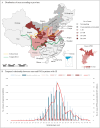Peripheral nerve injury associated with JEV infection in high endemic regions, 2016-2020: a multicenter retrospective study in China
- PMID: 38578315
- PMCID: PMC11036900
- DOI: 10.1080/22221751.2024.2337677
Peripheral nerve injury associated with JEV infection in high endemic regions, 2016-2020: a multicenter retrospective study in China
Abstract
Previously, we reported a cohort of Japanese encephalitis (JE) patients with Guillain-Barré syndrome. However, the evidence linking Japanese encephalitis virus (JEV) infection and peripheral nerve injury (PNI) remains limited, especially the epidemiology, clinical presentation, diagnosis, treatment, and outcome significantly differ from traditional JE. We performed a retrospective and multicenter study of 1626 patients with JE recorded in the surveillance system of the Chinese Center for Disease Control and Prevention, spanning the years 2016-2020. Cases were classified into type 1 and type 2 JE based on whether the JE was combined with PNI or not. A comparative analysis was conducted on demographic characteristics, clinical manifestations, imaging findings, electromyography data, laboratory results, and treatment outcomes. Among 1626 laboratory confirmed JE patients, 230 (14%) were type 2 mainly located along the Yellow River in northwest China. In addition to fever, headache, and disturbance of consciousness, type 2 patients experienced acute flaccid paralysis of the limbs, as well as severe respiratory muscle paralysis. These patients presented a greater mean length of stay in hospital (children, 22 years [range, 1-34]; adults, 25 years [range, 0-183]) and intensive care unit (children, 16 years [range, 1-30]; adults, 17 years [range, 0-102]). The mortality rate was higher in type 2 patients (36/230 [16%]) compared to type 1 (67/1396 [5%]). The clinical classification of the diagnosis of JE may play a crucial role in developing a rational treatment strategy, thereby mitigating the severity of the disease and potentially reducing disability and mortality rates among patients.
Keywords: Japanese encephalitis virus; clinical classification; electromyography; endemic; peripheral nerve injury.
Conflict of interest statement
No potential conflict of interest was reported by the author(s).
Figures



Similar articles
-
Genotypic variations and clinical implications of JEV-associated peripheral nerve injury: a commentary on multicenter findings from high-endemic regions.Emerg Microbes Infect. 2025 Dec;14(1):2449073. doi: 10.1080/22221751.2024.2449073. Epub 2025 Aug 28. Emerg Microbes Infect. 2025. PMID: 39781898
-
Incongruence between confirmed and suspected clinical cases of Japanese encephalitis virus infection.Front Cell Infect Microbiol. 2024 Jan 26;14:1302314. doi: 10.3389/fcimb.2024.1302314. eCollection 2024. Front Cell Infect Microbiol. 2024. PMID: 38343888 Free PMC article.
-
Sero-Molecular Epidemiology of Japanese Encephalitis in Zhejiang, an Eastern Province of China.PLoS Negl Trop Dis. 2016 Aug 25;10(8):e0004936. doi: 10.1371/journal.pntd.0004936. eCollection 2016 Aug. PLoS Negl Trop Dis. 2016. PMID: 27560360 Free PMC article.
-
Japanese encephalitis and Japanese encephalitis virus in mainland China.Rev Med Virol. 2012 Sep;22(5):301-22. doi: 10.1002/rmv.1710. Epub 2012 Mar 8. Rev Med Virol. 2012. PMID: 22407526 Review.
-
Acute flaccid paralysis as an unusual presenting symptom of Japanese encephalitis: a case report and review of the literature.Infection. 2007 Feb;35(1):30-2. doi: 10.1007/s15010-007-6038-7. Infection. 2007. PMID: 17297587 Review.
References
Publication types
MeSH terms
LinkOut - more resources
Full Text Sources
Other Literature Sources
Medical
